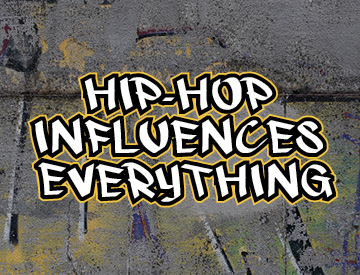Hip-Hop Influences Everything | News Center


“Probably everything,” says Moore. Hip-hop has influenced nearly every part of our lives. Innovation is one of the fundamental principles of hip-hop.
And Condit-Schultz says that hip-hop is a big part of all modern music-making. “Hip-hop came along and influenced a lot of vocal delivery and pop and rock,” he noted, pointing out that in the 1990s, a lot of what groups like Sublime or the Barenaked Ladies produced was greatly influenced by hip-hop. Even the melodies in Taylor Swift songs are now influenced by hip-hop, he says.
But hip-hop has not merely transformed songwriting and musical styles. It has also made an impact on the role of technology in music-making.
“Hip-hop has played an important role in pushing the field of music technology forward,” Freeman says, “because it has always been one of the most forward-thinking forms of music-making technologically, particularly one that looks at existing technologies that are out there and looks at ways to push that technology in ways that maybe its creators had not imagined.” Turntables are a great example of this.
Building on Freeman’s point, Wilson refers to what she calls hip-hop’s “genius” art of sampling, where artists can “go to the records, find the instrument that they need extracted, load it into a drum machine, manipulate it, and turn it into something completely different.” This iterative character of hip-hop, its ability to use technology to cannibalize other styles and forms, is one of its most important musical innovations.
Hip-hop’s cultural significance extends far beyond its broad musical influence, however.
Christian Coles, a lecturer in Georgia Tech’s School of Architecture, focuses his research on design that reflects marginalized and minority communities. His research, and that of his colleagues Michael Ford and Sekou Cooke, draws attention to the connections between the hip-hop movement and architecture.
“There were many different rappers who were actually speaking on the environment that they grew up in, and they were offering, basically, an intellectual critique of the different environments,” says Coles. Public housing projects were the backdrop of many rap songs, and they were typically designed in a modernist style, a style Coles says is often criticized because it didn’t suit the people it was built for.
Hip-hop inspires not only architecture and design thinking but also sustainable design solutions. “What hip-hop teaches,” says Coles, “is that things that we use as a day-to-day item, like a bottle or a piece of wood, can be remixed or recontextualized to be something inspirational in a whole other context.”
Coles introduced the subject of hip-hop and architecture in his design studio by borrowing from the framework of hip-hop and starting studio sessions with what he calls a design cypher. Promoting the idea of a democratic design process, one student starts the sketch, with subsequent students adding in turn — the process itself incorporating the framework of fluidity and remixing that stems from hip-hop culture.



